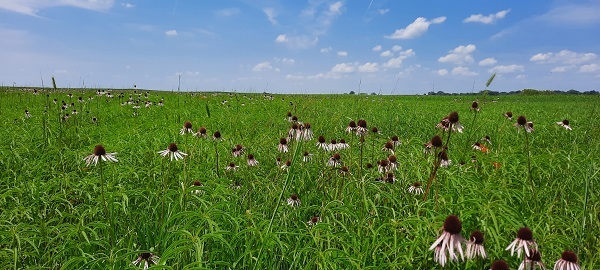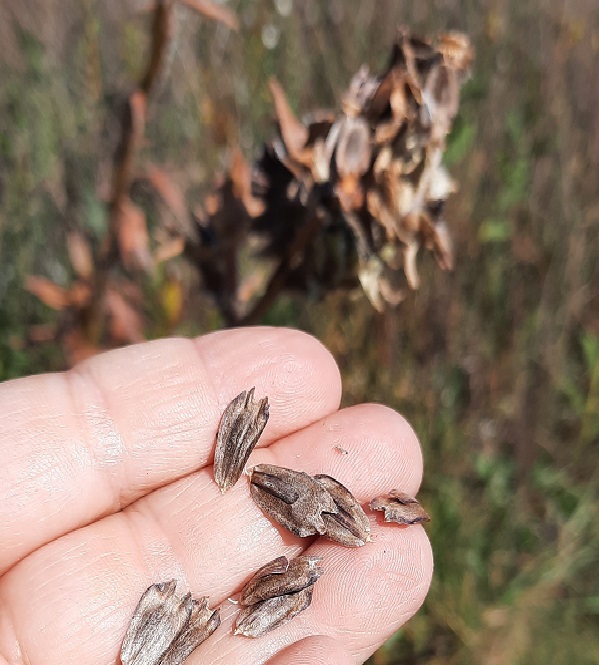
The Planting Prairie 101 Series will be a handful of articles that walk through the process of planting a prairie garden or a small patch of native prairie at your home. If you have 5 or more acres you’d like to restore to native prairie, please reach out to the DNR’s Private Lands Biologists.
This is the WILDLIFE Diversity News so why are we sending out an article focused on plants? Because Iowa’s native plants are the base that supports all of our native wildlife. The plants feed insects, which in turn are food for the birds which in turn are food for… you get the idea.
And why is it important that the plants be natives? Because native plants support more native wildlife! Doug Tallamy, Mr. Native Plants himself, gives an example that a native oak tree can support 542 species of butterfly or moth while the non-native Gingko tree supports 5 species.
One of the best things you can do to support pollinators and other wildlife, is to plant native plants. Iowa used to be covered in prairie and it can be again if enough of us plant a few of the hundreds of species that made up the tallgrass prairie ecosystem. It won’t look the same as 150 years ago but it can stop the loss of native wildlife like the endangered rusty-patched bumblebee and the monarch butterfly.
An endangered rusty-patched bumblebee feeds on butterfly milkweed (Asclepias tuberosa) in an urban yard.
One of the most frequent questions we hear from people interested in planting prairie is where do I get seeds/plants, so that is the focus of this first article of the series. The first thing for you to consider is whether your space warrants seed or plants.
Choose plants if:
- You have a small space to fill.
- You want flowers quickly.
- You want a more manicured looking garden.
Choose seed if:
- You have a larger space to fill.
- You want to save some money.
- You want a more natural looking “patch” of prairie.
- You don’t mind waiting for flowers.
You can also plant both of course! Even a natural-looking patch of prairie can look neater if a mowed border or other delineation is used to define the patch. So, with that decision made, here are a couple of options for securing seed and/or plants for your garden.
A monarch butterfly feeds on New England Aster. Photo by Bill Ohde.
This is going to be the lowest hassle method for procuring native plant material but it is not going to be as easy as buying ornamental annuals or perennials. Most typical greenhouses or chain stores will not carry a huge selection of native plants and those that they do carry will likely be cultivars (like the many color variants of the white native yarrow plant) and may have been grown with pesticides and other chemicals which should be avoided. There are a few native plant nurseries with store fronts around the state but they are not widespread.
The greatest variety of native plants and sources for them will be found through online retailers. To order from them will take some planning because you can’t just run out to shop on a Saturday. If ordering seed, the best time is late-summer/early fall. Seed is best planted in the late fall/early winter. Plants should be ordered during winter time for delivery usually in May.
It’s always a good idea to buy seed that originated in Iowa, especially if you live close by a natural area or want to ensure your plants are well adapted to your area. Look for yellow tag seed or Source ID seed to get seeds with an Iowa origin.
A database of Iowa native seed and plant producers, along with many other excellent resources, can be found on the Tallgrass Prairie Center’s Plant Iowa Native website.
*TIP*
Another place we’ve had luck finding native plant starts locally is at farmer’s markets and master gardener/garden club plant sales. Some County Conservation Boards also hold native plant sales (like this one) in early summer. So, keep your eyes and ears open for these kinds of opportunities.
Common milkweed seed bursting out of pod.
If you’re more adventurous and anxious to get started, now is a great time to start harvesting prairie seed. This is a fun and free way to bring native plants to your property OR a way to start more prairie from a patch you already have. However, before running out to your local county, state or federally owned prairie however, please ask permission first! It may not be legal to collect seed in some areas and the owners or managers will know best. Never dig up prairie plants!
When to collect is the next question to answer. Right now, early fall, is a good time for many species to have seed ready. The Tallgrass Prairie Center has a great brochure that includes a chart for timing your seed collecting forays.
Tips and Things to Know
- Start by only collecting seeds from one or two species of plants. You can focus on learning how to identify its dormant form and the best way to collect seed for that plant. This will help you to avoid feeling overwhelmed.
- Equipment needed are gloves, a good pair of small gardening shears and a few sacks to collect seed into.
- Collect seed into a breathable sack, not plastic where seed will mildew. Paper lunch bags work well and can also be easily labeled. Some seeds explode, such as Prairie violets, New Jersey tea, and Prairie phlox, so a closed paper bag may be necessary.
- If a species is rare (you are having trouble finding it at a site), it’s a good rule of thumb to not collect from it or only a small amount from one of a group of several plants.
- A year’s overall weather may impact germination rate. A drought like has been experienced in many places in Iowa will lower germination rate for many species.
- If you collect larger amounts of seed, then lay seed flat on a tarp and have a box fan blowing across the seed to keep it from spoiling
- Never dig up a prairie plant. It’s not a sustainable practice and will usually not be successful because of prairie plants’ extensive long root systems.
 |
The seeds from a cup plant.
Some common species and how to collect seed
-
Prairie Clovers (Dalea Sp.): Collect in late August into September. Seed heads should just easily crumbled into your hand. It can have poor germination rates.
-
Sunflowers and similar (Sunflowers, Cup Plant, Compass Plant, Prairie Dock etc…): Collect in September into October. The seeds are flat and papery and can be crumbled off of the seed head with your hand. These seeds are a favorite with birds so you may have some competition.
-
Blazing Star (Liatris sp.): Seed is fluffy and can be easily removed with hands in September to October.
-
Milkweed (Asclepias sp.): Seed is enclosed in pods. In September and October, the pods will start to dry and crack open. This is a good time to take the whole pod. Seed has a piece of fluff attached and should be removed. Fluff can be removed easier when damp so try to pick pods right when they crack open.
-
Hoary Vervain (Verbena stricta): Seeds will be on long stalk. Snip this off in October once dried and strip seed from it or just dump seed into bag.
How to store seed you've collected
Keep the seed in a cool, dark dry place in the paper bags and allow to dry further. We will talk about planting in the next installment of the Planting Prairie series but if you are interested in trying to grow plant starts from the seed, some additional storage techniques will be needed over winter. Most prairie seed requires a period of cold (stratification) to get the best germination so move the seed into moist soil or wrap in moist paper towels and put into the back of the fridge in December. Keep it there, making sure it stays just damp, for 6-8 weeks. At that time it can be removed and planted into seed starting pots and grown as any other plant.
WANT MORE INFORMATION?
There are so many great educational resources out there!
If you do plant some pollinator habitat or have already planted some in the last 3-4 years, it would help us track our progress towards our Monarch conservation goals if you would report it via HabiTally (iOS | android). Thanks!
|